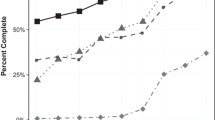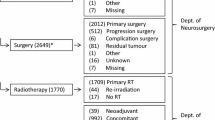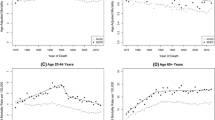Abstract
Central nervous system (CNS) tumors are categorized and graded for clinical and research purposes according to the World Health Organization (WHO) scheme which segregates tumors by histological type and predicted biological behavior. However, reporting of WHO grade in pathological reports is inconsistent despite its collection in cancer registration. We studied the completeness, concordancy, and yearly trends in the collection of WHO grade for primary CNS tumors between 2004 and 2011. Data from the Surveillance, Epidemiology and End Results program were analyzed for the percentage of histologically diagnosed primary CNS tumor cases with concordantly documented WHO grades between 2004 and 2011. Yearly trends were calculated with annual percentage changes (APC) and 95 % confidence intervals (95 % CI). Completeness and concordancy of the collection of WHO grade varied significantly by histological type and year. The percentage of cases with documented WHO grade increased significantly from 2004 to 2011: 39.0 % of cases in 2004 had documented WHO grade, while 77.5 % of cases had documented grade in 2011 (APC, 10.3; 95 % CI: 9.0, 11.5). Among cases with documented WHO grade, the percentage graded concordantly increased significantly from 89.1 % in 2004 to 93.7 % in 2007 (APC, 1.8; 95 % CI: 1.0, 2.6) and these values varied over time by histological type. One common trend among all histologies was a significant increase in the percentage of cases with documented WHO grade. A sizeable proportion of reported CNS tumors collected by cancer registrars have undocumented WHO grade, while a much smaller proportion are graded discordantly. Data collection on grade has improved in completeness and concordancy over time. Efforts to further improve collection of this variable are essential for clinical care and the epidemiological surveillance of CNS tumors.


Similar content being viewed by others
References
Zulch KJ (1979) Histological typing of tumours of the central nervous system. International histological classification of tumours, no 21. World Health Organization, Geneva
Kleihues P, Burger PC, Scheithauer BW, Zulch KJ (1993) Histological typing of tumours of the central nervous system, 2nd edn. Berlin, Springer-Verlag
Kleihues P, Cavenee WK, International Agency for Research on Cancer (2000) Pathology and genetics of tumours of the nervous system. IARC Press, Lyon
Louis DN, Ohgaki H, Wiestler OD, Cavenee WK (2007) WHO classification of tumours of the central nervous system. World Health Organization classification of tumours, 4th edn. International Agency for Research on Cancer, Lyon
Louis DN, Ohgaki H, Wiestler OD, Cavenee WK, Burger PC, Jouvet A, Scheithauer BW, Kleihues P (2007) The 2007 WHO classification of tumours of the central nervous system. Acta Neuropathol 114:97–109. doi:10.1007/s00401-007-0243-4
Pollo B (2011) Neuropathological diagnosis of brain tumours. Neurol Sci 32(Suppl 2):S209–S211. doi:10.1007/s10072-011-0802-2
Brat DJ, Parisi JE, Kleinschmidt-DeMasters BK, Yachnis AT, Montine TJ, Boyer PJ, Powell SZ, Prayson RA, McLendon RE, CoAP Neuropathology Committee (2008) Surgical neuropathology update: a review of changes introduced by the WHO classification of tumours of the central nervous system, 4th edition. Arch Pathol Lab Med 132:993–1007. doi:10.1043/1543-2165
Parisi JE, Miller DV, Boyer PJ, Brat DJ, Cochran EJ, Cohen ML, Demasters BK, Dolinak D, McComb RD, McLendon RE, Powell SZ, Prayson RA, Vinters HV, Yachnis AT, Members of Cancer Committee CoAP (2008) Protocol for the examination of specimens from patients with tumors of the brain/spinal cord. Arch Pathol Lab Med 132: 907–912 doi:10.1043/1543-2165
Combs SE, Schulz-Ertner D, Debus J, von Deimling A, Hartmann C (2011) Improved correlation of the neuropathologic classification according to adapted world health organization classification and outcome after radiotherapy in patients with atypical and anaplastic meningiomas. Int J Radiat Oncol Biol Phys 81:1415–1421. doi:10.1016/j.ijrobp.2010.07.039
Willis J, Smith C, Ironside JW, Erridge S, Whittle IR, Everington D (2005) The accuracy of meningioma grading: a 10-year retrospective audit. Neuropathol Appl Neurobiol 31:141–149. doi:10.1111/j.1365-2990.2004.00621.x
Kruchko C, Dolecek TA, McCarthy BJ (2011) A Review of the Collection of WHO Grade for Brain and CNS Tumors in Cancer Registration. Poster presented at: Society for Neuro-Oncology Annual Scientific Meeting and Education Day; Nov 17–20, 2011. Orange County, California
Surveillance Research Program—National Cancer Institute (2010) SEER… as a Research Resource. http://seer.cancer.gov/about/factsheets/SEER_Research_Brochure.pdf
Surveillance Epidemiology and End Results (SEER) Program SEER*Stat Database: Incidence—SEER 18 Regs Research Data + Hurricane Katrina Impacted Louisiana Cases, Nov 2013 Sub (1973-2011 varying)—Linked To County Attributes—Total U.S., 1969-2012 Counties, National Cancer Institute, DCCPS, Surveillance Research Program, Surveillance Systems Branch, released April 2014, based on the November 2013 submission
(2002) Benign Brain Tumor Cancer Registries Amendment Act. http://www.gpo.gov/fdsys/pkg/PLAW-107publ260/pdf/PLAW-107publ260.pdf. Accessed 4 June 2014
Surveillance Epidemiology and End Results (SEER) Program (2013) SEER Program Coding and Staging Manual 2013. http://seer.cancer.gov/archive/manuals/2013/SPCSM_2013_maindoc.pdf. Accessed 4 June 2014
Collaborative Stage Data Collection System (2013) Brain: CS Site-Specific Factor 1, World Health Organization (WHO) Grade Classification. http://web2.facs.org/cstage0205/brain/Brain_jpo.html. Accessed 5 June 2014
Ostrom QT, Gittleman H, Liao P, Rouse C, Chen Y, Dowling J, Wolinsky Y, Kruchko C, Barnholtz-Sloan JS (2014) CBTRUS statistical report: primary brain and central nervous system tumors diagnosed in the United States in 2007–2011. Neuro Oncol 16: iv1–iv63. doi:10.1093/neuonc/nou223
Surveillance Epidemiology and End Results (SEER) Program SEER Training Modules, Cancer Diagnosis. U. S. National Institutes of Health, National Cancer Institute. http://training.seer.cancer.gov/. Accessed 20 June 2014
Louis DN, Perry A, Burger P, Ellison DW, Reifenberger G, von Deimling A, Aldape K, Brat D, Collins VP, Eberhart C, Figarella-Branger D, Fuller GN, Giangaspero F, Giannini C, Hawkins C, Kleihues P, Korshunov A, Kros JM, Beatriz Lopes M, Ng HK, Ohgaki H, Paulus W, Pietsch T, Rosenblum M, Rushing E, Soylemezoglu F, Wiestler O, Wesseling P (2014) International society of neuropathology-haarlem consensus guidelines for nervous system tumor classification and grading. Brain Pathol 24:429–435. doi:10.1111/bpa.12171
Detti B, Scoccianti S, Di Cataldo V, Monteleone E, Cipressi S, Bordi L, Pellicano G, Gadda D, Saieva C, Greto D, Pecchioli G, Buccoliero A, Ceroti M, Ammannati F, Biti G (2013) Atypical and malignant meningioma: outcome and prognostic factors in 68 irradiated patients. J Neurooncol 115:421–427. doi:10.1007/s11060-013-1239-7
Simon M, Bostrom J, Koch P, Schramm J (2006) Interinstitutional variance of postoperative radiotherapy and follow up for meningiomas in Germany: impact of changes of the WHO classification. J Neurol Neurosurg Psychiatry 77:767–773. doi:10.1136/jnnp.2005.077974
Yang SY, Park CK, Park SH, Kim DG, Chung YS, Jung HW (2007) Atypical and anaplastic meningiomas: prognostic implications of clinicopathological features. J Neurol Neurosurg Psychiatry 79:574–580. doi:10.1136/jnnp.2007.121582
Rosenberg LA, Prayson RA, Lee J, Reddy C, Chao ST, Barnett GH, Vogelbaum MA, Suh JH (2009) Long-term experience with world health organization grade III (malignant) meningiomas at a single institution. Int J Radiat Oncol Biol Phys 74:427–432. doi:10.1016/j.ijrobp.2008.08.018
Funding
The following organizations contributed to the maintenance of the CBTRUS database: the Centers for Disease Control and Prevention (CDC) under Agreement 5U58DP00381-04, The Sontag Foundation (www.sontagfoundation.org), Genentech (www.gene.com), the Pediatric Brain Tumor Foundation (www.curethekids.org), Novocure, Inc. (www.novocure.com), along with the Musella Foundation (www.virtualtrials.com), Voices Against Brain Cancer (www.voicesagainstbraincancer.org), Elekta (www.elekta.com), as well as private and in kind donations. Contents are solely the responsibility of the authors and do not necessarily represent the official views of the CDC.
Conflict of interest
There are no conflicts of interest to report.
Author information
Authors and Affiliations
Corresponding authors
Rights and permissions
About this article
Cite this article
Lym, R.L., Ostrom, Q.T., Kruchko, C. et al. Completeness and concordancy of WHO grade assignment for brain and central nervous system tumors in the United States, 2004–2011. J Neurooncol 123, 43–51 (2015). https://doi.org/10.1007/s11060-015-1775-4
Received:
Accepted:
Published:
Issue Date:
DOI: https://doi.org/10.1007/s11060-015-1775-4




